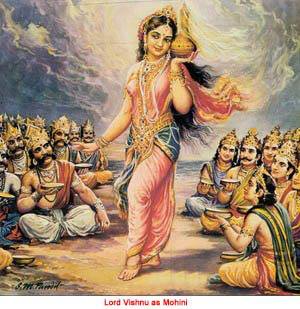srI:
srImathE satakOpAya nama:
srImathE rAmAnujAya nama:
srImath varavaramunayE nama:
Full series >> First Centum >> Seventh decad
Introduction for this pAsuram
Highlights from thirukkurukaippirAn piLLAn‘s introduction
No specific introduction.
Highlights from nanjIyar‘s introduction
In ninth pAsuram – AzhwAr realizing the abundance of his communion with emperumAn, says that there is no question of separation.
Highlights from vAdhi kEsari azhagiya maNavALa jIyar‘s introduction
Subsequently, AzhwAr asks “is there any reason for my AthmA to think about separation, after having communion with him in all possible ways?”.
Highlights from periyavAchchAn piLLai‘s introduction
See nanjIyar‘s introduction.
Highlights from nampiLLai‘s introduction as documented by vadakkuth thiruvIdhip piLLai
Ninth pAsuram – What is the reason for saying “thAnum killAn” (even he is not capable to leave me)? AzhwAr asks “When emperumAn and I look like a single entity, where is the question of separation?”
pAsuram
அமரர் முழு முதல் ஆகிய ஆதியை
அமரர்க்கு அமுது ஈந்த ஆயர் கொழுந்தை
அமர அழும்பத் துழாவி என் ஆவி
அமரத் தழுவிற்று இனி அகலும்மோ?
amarar muzhu mudhal Agiya Adhiyai
amararkku amudhu Indha Ayar kozhundhai
amara azhumbath thuzhAvi en Avi
amarath thazhuviRRu ini agalumO?
Listen
Word-by-Word meanings (based on vAdhi kEsari azhagiya maNavALa jIyar‘s 12000 padi)
amarar – nithyasUris’
muzhu – (svarUpa – true nature, sthithi – existence, pravruththi – actions etc) all
mudhalAgiya – have it as cause
Adhiyai – being the primary/leader
amararkku – for the dhEvas
amudhu – nectar (which they desired for)
Indha – one who gave
Ayar – for the cow-herd boys (who were related to him)
kozhundhai – one who is the leader
en Avi – my AthmA (soul)
amara – becoming fit (to be only existing for emperumAn)
azhumba – mixing with him (to eliminate the hurdles such as svAthanthriyam (independence) etc)
thuzhAvi – analysed (through many aspects such as svarUpam etc)
amara – being together (without separation)
thazhuviRRu – embraced him
ini agalumO – is there any scope for separation?
Simple transalation (based on vAdhi kEsari azhagiya maNavALa jIyar‘s 12000 padi)
Once my AthmA became fit to be fully existing for him after analysing many aspects and embraced emperumAn, on whom nithyasUris fully depend for their sustenance, existence, activities etc., who is the leader of such nithyasUris, who gave the nectar to the dhEvas and who is the leader of cow-herd clan, is there any question of separation?
vyAkyAnams (commentaries)
Highlights from thirukkurukaippirAn piLLAn‘s vyAkyAnam
See vAdhi kEsari azhagiya maNavALa jIyar‘s translation.
Highlights from nanjIyar‘s vyAkyAnam
See nampiLLai‘s vyAkyAnam.
Highlights from periyavAchchAn piLLai‘s vyAkyAnam
See nampiLLai‘s vyAkyAnam.
- Ayar kozhundhai – bhagavath gIthA 4.8 “parithrANAya sAdhUnAm …” (Time after time, I descend to protect my devotees…).
Highlights from nampiLLai‘s vyAkyAnam as documented by vadakkuth thiruvIdhip piLLai
- amarar muzhu mudhal Agiya – nithyasUris have bhagavAn as the reason for their svarUpam, sthithi etc.
- Adhiyai – starting with this, leelA vibhUthi (material realm) is explained. bhagavAn is the one who bestows the senses, body etc to even those are not fully devoted to him.
- amararkku amudhu Indha – dhEvas who accepted the senses/body which were given by him said “We don’t want you; just the salt-water (amudhu-nectar) is enough” [since this nectar only elongates the life-span for a longer duration in this material realm] – for such dhEvas too, he churned the milky ocean and gave the amrutham.
- Ayar kozhundhai – He descended as krishNa to those who said they want emperumAn only and not the amrutham and gave himself to them.
- amara … – Approached such emperumAn who is with both spiritual realm and material realm, enjoyed him in several ways and mixed with him so much that it became difficult for me to distinguish myself from him.
- ini agalumO – Only when two entities are visible, could they be separated. Once prakAra (body) and prakAri (substratum) are understood as one, can they be separated? [bhagavAn is the substratum [that which beholds everything] and AthmA is a body/attribute of bhagavAn]. Just like a form and its attributes are inseparable, when an entity (jIvAthmA) becomes fully attached to another entity (bhagavAn), those also become inseparable.
In the next article we will enjoy the next pAsuram.
adiyen sarathy ramanuja dasan
archived in http://divyaprabandham.koyil.org
pramEyam (goal) – http://koyil.org
pramANam (scriptures) – http://srivaishnavagranthams.wordpress.com
pramAthA (preceptors) – http://acharyas.koyil.org
srIvaishNava education/kids portal – http://pillai.koyil.org
